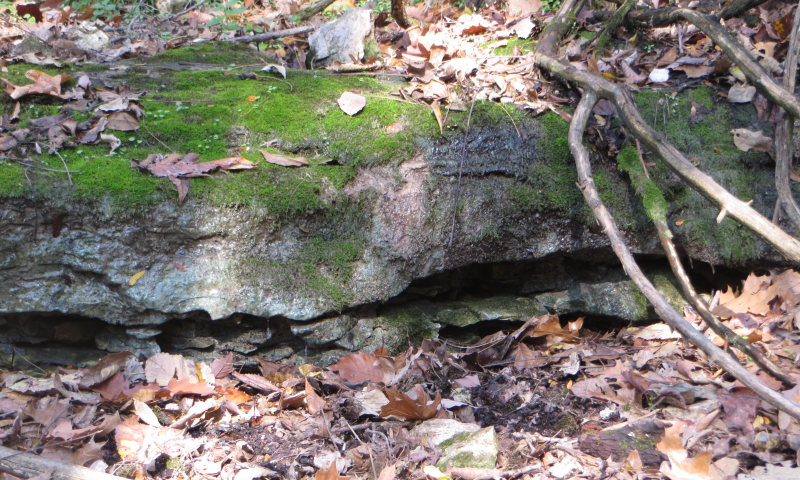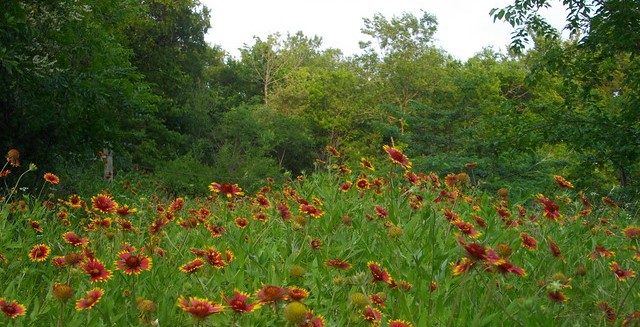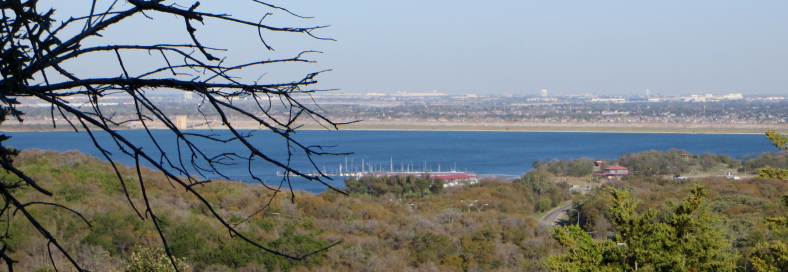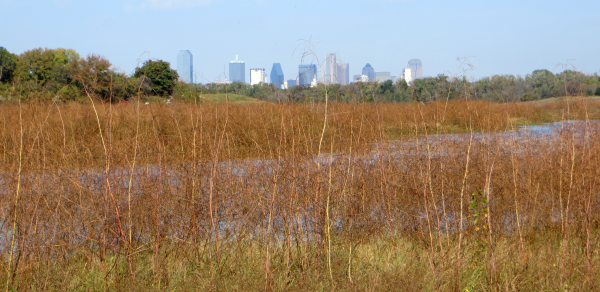Also see: Op-Ed: Preserve Local Parks Grants , adapted from this essay
Like many in my parents’ generation, my Gen-X childhood was spent outside whenever possible, with the freedom to roam the neighborhood and explore the vestiges of “the wild” wherever they could be found. In southern Missouri, that meant playing in small valleys, not fit for home construction, that still teemed with minnows, crawdads, and the occasional alligator snapping turtle. Even the backyard offered something wild: instead of a fence separating us from our neighbors, we had an old farm tree line; some of the larger horse apple trees still had bits of barb wire encased in their bark. The trees sheltered squirrels and chipmunks, birds and bats.

Small ledge and spring, along a minor brook emptying into Lake
Springfield, Missouri
And then we moved to Plano, in the middle of 7th grade. Again our home was on old farmland, but there were no vestiges other than the flatness of tilled cropland. White Rock Creek was perhaps a mile away, but there was no access without obviously trespassing — and it wasn’t compelling enough to risk getting in trouble. I turned inward and focused on my studies; perhaps that was for the best. But I felt lost. A part of me was missing.
Thankfully, those first few summers did include memorable respites from the suburban lifestyle: trips back to Missouri, a few visits to Dinosaur Valley State Park, and the transcendent experience of looking up into the redwood crowns of Yosemite and Muir Woods. But there was one other trip, shortly after tenth grade, that dwarfed them all in personal significance: the science club went out to McDonald Observatory and Big Bend National Park. It was there that the rehabilitation of my disconnect from nature began.
Sometime in the following year, a friend who was also on that trip introduced me to Spring Creek Forest Preserve in Richardson, about 15 miles away from home. I was stunned to find this bit of “wild” just a few miles east of the density of North Dallas. Eventually, we also discovered Bob Woodruff Park in Plano, but it was Spring Creek that captured my heart. Soon, however, it was time for college.
 Gaillardia flowers at Spring Creek Forest Preserve in Richardson
and Garland.
Gaillardia flowers at Spring Creek Forest Preserve in Richardson
and Garland.
Some rights
reserved by
gurdonark
My blood runs orange, and going to Austin felt like going home at last. There, I found comfort and respite at the turtle pond north of the Tower, and in staring down into the waters of Waller Creek swirling amidst Cypress knobs. Soccer games at Zilker Park introduced me to the water and woods of Barton Creek and the Colorado River, right in the heart of the city. Mayfield Park and Mount Bonnell, just west of downtown, offered further refuge from the stress of my studies. With a bit more free time after graduation, I was able to get out a little further with visits to state parks like McKinney Falls, Bastrop, Enchanted Rock, Pedernales Falls, and Lost Maples.
After some time away from Texas, I am now on the south side of Dallas County, where the many preserves and parks in Dallas, Grand Prairie, and Cedar Hill have been critical to maintaining my personal well-being. My favorite hang-out is at Dogwood Canyon Audubon Center, from whose ridge one can alternately look out over Joe Pool Lake to the north, spotting Cowboys Stadium on a clear day; or circle round to the south, and study the texture of the oak-and-juniper woods of the canyon. Fish Creek Preserve in Grand Prairie and Joppa Preserve in Dallas are other common destinations. Plano, too, has grown up over the years: Arbor Hills now provides an excellent western counterpart to Bob Woodruff.

Joe Pool Overlook, Dogwood Canyon Audubon Center at Cedar Hill
While my personal faith plays an important role in helping keep me from the slough of indifference to the ills of society, it is these near and far Texas natural spaces that allow me to breathe and connect with a feeling of the divine; to feel that I am but a small part of the natural order; to re-discover the wonder of an ant-lion nest or to admire the fall color in prairie grasses as well as trees. Transcendence comes easily in the redwoods, but it is also to be found under the shade of a mighty pecan tree or in studying the chalk layers revealed by our Dallas-area creeks. We need these places to keep us whole, to keep our minds sharp, our creativity stimulated, and our anxieties at bay. This is not merely personal anecdote, but also proven science: humans thrive best in settings that allow proximity to “nature”, however that might be defined†. Without these spaces, I could not bear to remain in Texas — it would not be the land I love, but just another Sprawl.

Wetlands southeast of downtown Dallas.
† The book Urban Place: Reconnecting with the Natural World, edited by Peggy F. Barlett, offers a good review of the science. Richard Louv has written extensively about what he calls nature deficit disorder. Renowned biologist-humanist E.O. Wilson hypothesises a genetic basis for the human connection to nature, biophilia (PBS interview 2008).
Posted with : Social Discourse, Life Lived Living, Nature, Sustainability, Environment, Wildlife